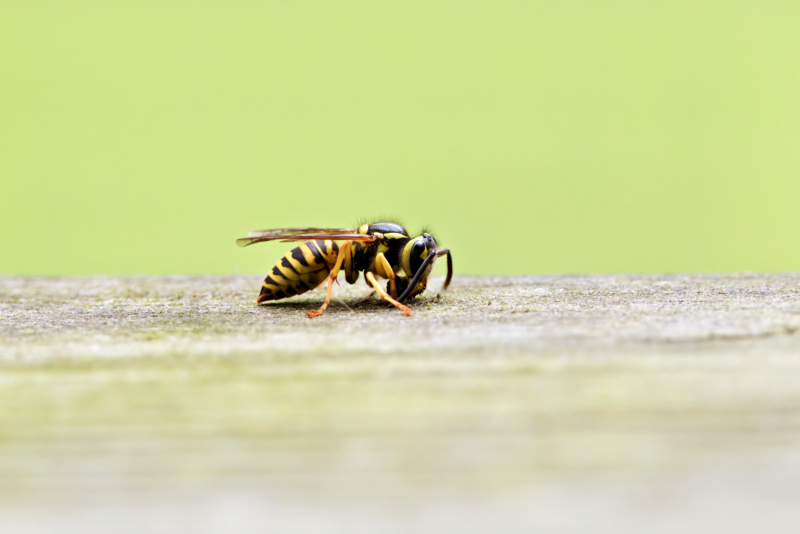The other day, while photographing birds from my deck, I noticed a yellowjacket on the deck rail nearby. Watching it closely, I was reminded of the intricate and fascinating behaviors these tiny creatures exhibit, particularly when it comes to nest building. It’s easy to overlook these industrious insects, but when you take a moment to observe them, there’s a whole world of activity going on right under our noses.

A Master Builder at Work
Yellowjackets are expert builders, and their nests are true marvels of natural engineering. They use wood fibers, which they gather by chewing on wooden surfaces like boards, fences, or, in my case, the deck rail. The yellowjacket I observed was likely collecting these fibers, mixing them with its saliva to create a papery substance. This material is the foundation of their nest—a structure that is both strong and lightweight, allowing for easy expansion as the colony grows.
Interestingly, yellowjackets can be quite resourceful with their building materials. In captivity, they’ve been known to use colored construction paper if it’s available, resulting in nests with vibrant, multi-colored cells. It’s a testament to their adaptability and ingenuity.
The Architecture of a Yellowjacket Nest
Yellowjackets are not picky about where they build their nests. They can be found underground in old rodent burrows, inside hollow trees, or even in human-made structures like attics, sheds, or porches. The nest itself is a layered structure composed of combs that house the larvae, all surrounded by a protective paper envelope. The layers are meticulously constructed, and as the colony grows, so does the nest, expanding to accommodate the increasing number of inhabitants.
I’ve had my share of close encounters with yellowjackets nesting in my yard over the years. There’s a certain respect you develop for these creatures when you see how tirelessly they work to build and maintain their homes. They’re not just random pests; they’re skilled architects and dedicated workers, playing a vital role in the ecosystem.
The Life Cycle of a Yellowjacket Colony
The lifecycle of a yellowjacket colony is a story of growth, teamwork, and survival. It all starts with a single queen in the spring. She constructs a small initial nest and lays the first eggs. As these eggs hatch and the larvae develop into workers, they take over the foraging and nest-building duties, allowing the queen to focus solely on laying eggs.
Throughout the summer, the colony continues to expand, reaching its peak size in late summer or early fall. By this time, a single nest can house hundreds or even thousands of workers, all busily maintaining the nest and caring for the next generation.
However, as fall approaches, the colony faces new challenges. Food becomes scarcer, and yellowjackets can become more aggressive as they search for sustenance. This is often when we humans notice them more, as they’re more likely to come into our spaces in search of food. But it’s also the beginning of the end for the colony. As winter sets in, the workers die off, and only the new queens survive, hibernating until spring, when they’ll start the cycle all over again.
A Small Creature with Big Impact
Seeing that yellowjacket on my deck reminded me of the intricate and often unnoticed lives of these tiny creatures. While they can be a nuisance, especially in the fall, they are also fascinating and essential parts of our ecosystem. Their nest-building skills are nothing short of remarkable, and their role in nature is a reminder of the complex interconnections in the world around us.
So next time you see a yellowjacket buzzing around, take a moment to appreciate the work that goes into building their homes. These little architects have a lot to teach us about resourcefulness, teamwork, and the beauty of nature’s designs.

I just learned something new when I read your post. I really never did think about how a nest was built, and with what materials used. They are strong hives for sure. Thanks for the information.
Another very interesting post. Thank you for sharing it.
Thanks for taking the time to read my posts!
Thank you, Steve
Thank you! I’m glad you enjoy my blog posts and photos!